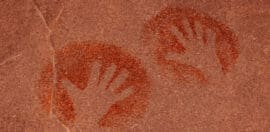What does effective philanthropy look like?

Colin Macfarlane at the opening of Walk for Life clinic at Rajshahi Hospital in Bangladesh.
1 June 2021 at 7:15 am
How a unique partnership between The Glencoe Foundation and Action on Poverty (AOP) has helped over 28,000 children with clubfoot walk for life.
When Fahim* was born to a rickshaw puller and his wife in Bhola, Bangladesh, the family was overjoyed. However, as the new baby settled with his mother, they realised there was something unusual about his feet. Both were turned inward at a 90-degree angle.
Fahim had bilateral clubfoot. In Bangladesh, up to 5,000 children are born with the congenital condition every year. Social stigma and lack of affordable treatment mean that children like Fahim are often kept out of school, struggle to find decent work, and remain trapped in the poverty cycle. Many people with clubfoot are forced to beg or take on menial labour to survive.
Fahim’s family didn’t think they would be able to afford treatment. In fact, no one knew if the condition even had a cure, and they feared for the boy’s future.

Combining vision with generosity
Colin Macfarlane, an Australian philanthropist and founder of The Glencoe Foundation, knew about the prevalence of clubfoot in Bangladesh and saw the chance to make a difference.
Macfarlane already had extensive experience in creating health programs in developing countries in south and south-east Asia. While working with a team of Australian and Bangladeshi doctors on a cleft palate project, he heard about the lack of effective treatment for clubfoot patients.
“A Bangladeshi surgeon told me he was disappointed with results from surgically correcting clubfoot,” Macfarlane said.
“At the time, the Ponseti technique was gaining in popularity.”
The Ponseti technique is a non-surgical technique that involves manipulation, casting and bracing to gradually bring the feet into the correct alignment and enable a child to walk.
“I visited Ponseti experts in the UK, Canada and the USA, and realised the potential for establishing a country-wide program in Bangladesh,” Macfarlane said.
“Then I got lucky. I met with Professor Ruhal Haque, the minister for health at the time, and himself an orthopaedic surgeon well-versed in the Ponseti technique. He threw his support behind the project.”
The Glencoe Foundation partnered with Action on Poverty (AOP), an Australian NGO that connects philanthropists and not for profits with developing communities abroad, to establish the Walk for Life project.
The Walk for Life project trains medical professionals in the Ponseti technique, raises awareness of the condition and educates doctors about referring children to clubfoot clinics. AOP helped to design and manage the program, and also contributed additional funding from the Australian government.
Today, Walk for Life services communities across Bangladesh and Myanmar, enabling disadvantaged children like Fahim to access free, life-changing treatment.
A chance to walk for life
In Bhola, Fahim’s mother took him to her local doctor to find out if any treatment was available. Because of the project’s awareness-raising campaigns, the doctor knew to refer her to a Walk for Life clinic.
At just one month old, Fahim began free treatment using the Ponseti technique. At first, the family was distressed to see their baby wearing casts and braces, but their doctor helped them understand the long-term benefits and Fahim tolerated the treatment well.
Fahim’s feet were corrected after five consecutive castings. He still wears braces at night and his parents are diligent in following the treatment protocol to avoid any relapse. Their physio remains in touch with them via a mobile app to remind them of follow-up appointments.
“Walk for Life showed me the way of dreaming,” Fahim’s mother said.
“God willing, one day my son will be a doctor.”

Creating long-term change
The Walk for Life project is now a nation-wide program supported by the Bangladeshi government with referrals from over 13,000 community health clinics.
The clinics operate on a “user pays” model, with those who are able to afford treatment subsidising the cost of care for those who can’t, like Fahim. Today, over 50 per cent of patients are able to pay, so international donors are no longer covering the cost of treatment but instead supporting training and awareness-building.
“Walk for Life grew very fast,” Macfarlane said.
“It used to rely on individual donors, but going forward this is not sustainable. With this model, the project is becoming self-sustaining. This is an example of social enterprise. A small investment can lead to enormous social and economic returns in the future.”
Together, The Glencoe Foundation and AOP have helped over 28,000 children with clubfoot walk for life. With a strong, capable health care system capable of treating clubfoot, many more children will continue to have access to free or low-cost treatment, helping them reach their full potential.
“There are always opportunities to make a difference,” Macfarlane said.
“The reward is to see first-hand the transformation in children’s lives.”
For more information on how AOP can help you follow in Colin’s footsteps, visit actiononpoverty.org/partnerships
*Name changed







